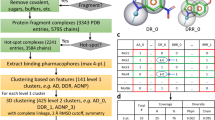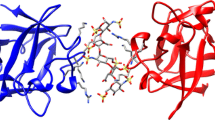Abstract
A combined strategy based on the development of pharmacophore hypotheses and NMR approaches is reported for the identification of novel inhibitors of heparanase, a key enzyme involved in tumor metastasis through the remodeling of the subepithelial and subendothelial basement membranes, resulting in the dissemination of metastatic cancer cells. Several pharmacophore hypotheses were initially developed from the most active heparanase inhibitors known to date and, after their application to a pool of 27 known heparanase inhibitors and a database of 1,120 compounds approved by the FDA, a four-point pharmacophore model was selected as the most predictive. This model was subsequently applied to a database of 686 chemical fragments, and a subset of 100 fragments accomplishing completely or partially the four-point model was selected to perform nuclear magnetic resonance experiments to validate the hypothesis. The experimental studies confirmed the reliability of our pharmacophore model, its applicability to in silico databases in order to reduce the number of compounds to be experimentally screened, and the possibility of generating fragment libraries enriched in heparanase inhibitors.






Similar content being viewed by others
References
Nasser NJ (2008) Heparanase involvement in physiology and disease. Cell Mol Life Sci 65(11):1706–1715. doi:10.1007/s00018-008-7584-6
Levy-Adam F, Feld S, Suss-Toby E et al (2008) Heparanase facilitates cell adhesion and spreading by clustering of cell surface heparan sulfate proteoglycans. PLoS One 3(6):e2319. doi:10.1371/journal.pone.0002319
Ilan N, Elkin M, Vlodavsky I (2006) Regulation, function and clinical significance of heparanase in cancer metastasis and angiogenesis. Int J Biochem Cell Biol 38(12):2018–2039. doi:10.1016/j.biocel.2006.06.004
Vlodavsky I, Ilan N, Naggi A et al (2007) Heparanase: structure, biological functions, and inhibition by heparin-derived mimetics of heparan sulfate. Curr Pharm Des 13(20):2057–2073. doi:10.2174/138161207781039742
Vlodavsky I, Friedmann Y (2001) Molecular properties and involvement of heparanase in cancer metastasis and angiogenesis. J Clin Invest 108(3):341–347
Hulett MD, Hornby JR, Ohms SJ et al (2000) Identification of active-site residues of the pro-metastatic endoglycosidase heparanase. Biochemistry 39(51):15659–15667. doi:10.1021/bi002080p
Khachigian LM, Parish CR (2004) Phosphomannopentaose sulfate (PI-88): heparan sulfate mimetic with clinical potential in multiple vascular pathologies. Cardiovasc Drug Rev 22(1):1–6
Hammond E, Bytheway I, Ferro V (2006) Heparanase as a target for anticancer therapeutics: new developments and future prospects. In: Delehedde M, Lortat-Jacob H (eds) New developments in therapeutic glycomics. Research Signpost, Kerala, India
Güner OF (2000) Pharmacophore perception, development, and use in drug design. International University Line, La Jolla, California
Güner OF (2002) History and evolution of the pharmacophore concept in computer-aided drug design. Curr Top Med Chem 2(12):1321–1332. doi:10.2174/1568026023392940
Wolber G, Seidel T, Bendix F et al (2008) Molecule-pharmacophore superpositioning and pattern matching in computational drug design. Drug Discov Today 13(1–2):23–29. doi:10.1016/j.drudis.2007.09.007
Wermuth CG, Ganellin CR, Lindberg P et al (1998) Glossary of terms used in medicinal chemistry (IUPAC Recommendations 1997). Annu Rep Med Chem 33:385–395. doi:10.1016/S0065-7743(08)61101-X
Huang N, Shoichet BK, Irwin JJ (2006) Benchmarking sets for molecular docking. J Med Chem 49(23):6789–6801. doi:10.1021/jm0608356
Congreve M, Carr R, Murray C et al (2003) A ‘rule of three’ for fragment-based lead discovery? Drug Discov Today 8(19):876–877. doi:10.1016/S1359-6446(03)02831-9
Dalvit C, Fogliatto G, Stewart A et al (2001) WaterLOGSY as a method for primary NMR screening: practical aspects and range of applicability. J Biomol NMR 21(4):349–359. doi:10.1023/A:1013302231549
Hwang T-L, Shaka AJ (1995) Water suppression that works: excitation sculpting using arbitrary waveforms and pulse field gradients. J Magn Reson A 112:275–279. doi:10.1006/jmra.1995.1047
Meyer B, Peters T (2003) NMR spectroscopy techniques for screening and identifying ligand binding to protein receptors. Angew Chem Int Ed Engl 42(8):864–890. doi:10.1002/anie.200390233
Ludwig C, Michiels PJA, Wu X et al (2008) SALMON: solvent accessibility, ligand binding, and mapping of ligand orientation by NMR spectroscopy. J Med Chem 51(1):1–3. doi:10.1021/jm701020f
Stockman BJ, Kothe M, Kohls D et al (2009) Identification of allosteric PIF-pocket ligands for PDK1 using NMR-based fragment screening and 1H–15N TROSY experiments. Chem Biol Drug Des 73(2):179–188. doi:10.1111/j.1747-0285.2008.00768.x
Klages J, Coles M, Kessler H (2007) NMR-based screening: a powerful tool in fragment-based drug discovery. Analyst 132(7):693–705. doi:10.1039/b709658p
Siegal G, Ab E, Schultz J (2007) Integration of fragment screening and library design. Drug Discov Today 12(23–24):1032–1039. doi:10.1016/j.drudis.2007.08.005
Petitjean M (1992) Applications of the radius-diameter diagram to the classification of topological and geometrical shapes of chemical compounds. J Chem Inf Comput Sci 32(4):331–337. doi:10.1021/ci00008a012
Dalvit C (2007) Ligand- and substrate-based 19F NMR screening: principles and applications to drug discovery. Prog Nucl Magn Reson Spectrosc 51:243–271. doi:10.1016/j.pnmrs.2007.07.002
Ji H, Stanton BZ, Igarashi J et al (2008) Minimal pharmacophoric elements and fragment hopping, an approach directed at molecular diversity and isozyme selectivity. Design of selective neuronal nitric oxide synthase inhibitors. J Am Chem Soc 130(12):3900–3914. doi:10.1021/ja0772041
Acknowledgments
The authors wish to thank the Spanish Ministerio de Ciencia e Innovación (MCINN, SAF2008-01845), the Fundación de Investigación Médica Mutua Madrileña and the Centro de Investigación Príncipe Felipe for economic support. We also acknowledge the financial support provided by the Access to Research Infrastructures activity in the 6th FP of the EC (Contract #RII3-026145, EU-NMR), and the CERM for providing technical support. S.M. and R.J.C are recipients of a FPI predoctoral fellowship and a contract of the Ramón y Cajal program from the MCINN, respectively.
Author information
Authors and Affiliations
Corresponding author
Additional information
Rafael Gozalbes and Silvia Mosulén contributed equally to this work.
Rights and permissions
About this article
Cite this article
Gozalbes, R., Mosulén, S., Carbajo, R.J. et al. Development and NMR validation of minimal pharmacophore hypotheses for the generation of fragment libraries enriched in heparanase inhibitors. J Comput Aided Mol Des 23, 555–569 (2009). https://doi.org/10.1007/s10822-009-9269-0
Received:
Accepted:
Published:
Issue Date:
DOI: https://doi.org/10.1007/s10822-009-9269-0




